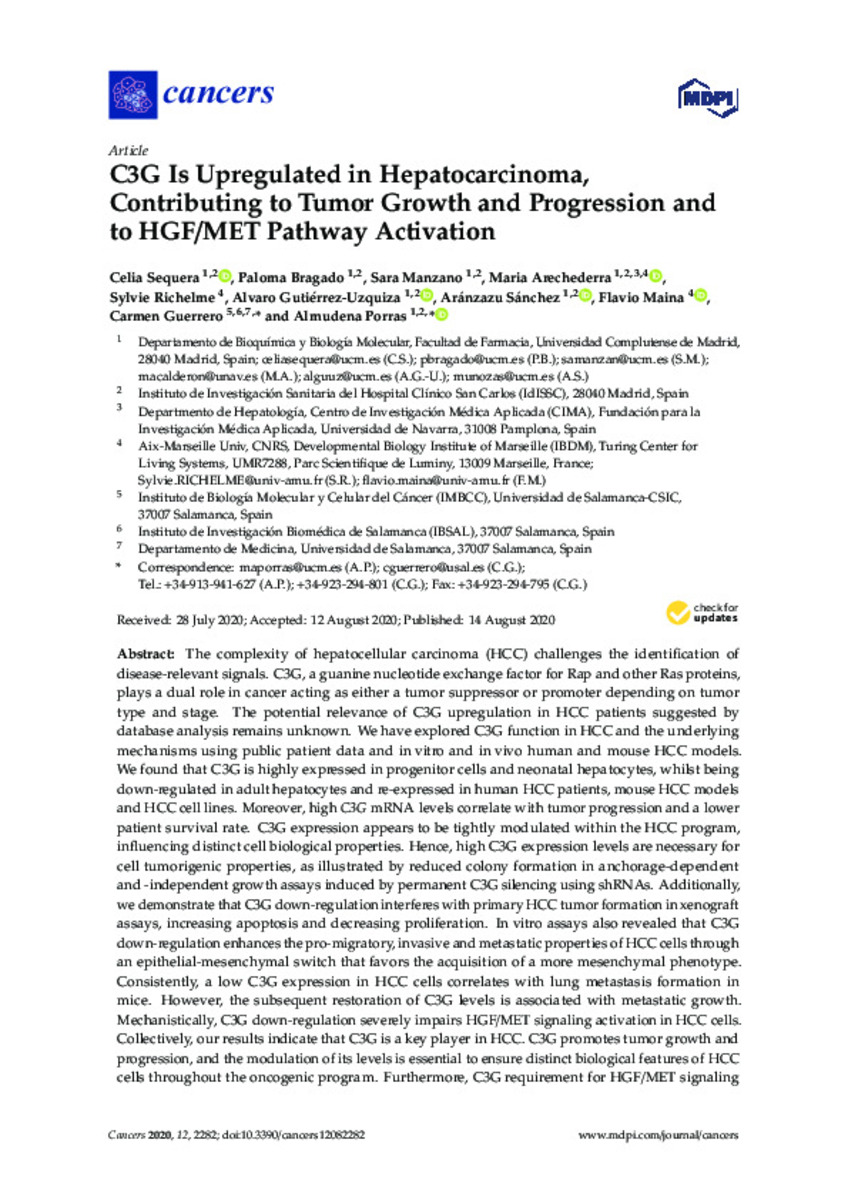Full metadata record
| DC Field | Value | Language |
|---|---|---|
| dc.creator | Sequera, C. (Celia) | - |
| dc.creator | Bragado, P. (Paloma) | - |
| dc.creator | Manzano, S. (Sara) | - |
| dc.creator | Arechederra, M. (María) | - |
| dc.creator | Richelme, S. (Sylvie) | - |
| dc.creator | Gutiérrez-Uzquiza, A. (Alvaro) | - |
| dc.creator | Sánchez, A. (Aránzazu) | - |
| dc.creator | Maina, F. (Flavio) | - |
| dc.creator | Guerrero, C. (Carmen) | - |
| dc.creator | Porras, A. (Almudena) | - |
| dc.date.accessioned | 2023-02-23T14:12:58Z | - |
| dc.date.available | 2023-02-23T14:12:58Z | - |
| dc.date.issued | 2020 | - |
| dc.identifier.citation | Sequera, C. (Celia); Bragado, P. (Paloma); Manzano, S. (Sara); et al. "C3G Is Upregulated in Hepatocarcinoma, Contributing to Tumor Growth and Progression and to HGF/MET Pathway Activation". Cancers. 12 (8), 2020, | es_ES |
| dc.identifier.issn | 2072-6694 | - |
| dc.identifier.uri | https://hdl.handle.net/10171/65538 | - |
| dc.description.abstract | The complexity of hepatocellular carcinoma (HCC) challenges the identification of disease-relevant signals. C3G, a guanine nucleotide exchange factor for Rap and other Ras proteins, plays a dual role in cancer acting as either a tumor suppressor or promoter depending on tumor type and stage. The potential relevance of C3G upregulation in HCC patients suggested by database analysis remains unknown. We have explored C3G function in HCC and the underlying mechanisms using public patient data and in vitro and in vivo human and mouse HCC models. We found that C3G is highly expressed in progenitor cells and neonatal hepatocytes, whilst being down-regulated in adult hepatocytes and re-expressed in human HCC patients, mouse HCC models and HCC cell lines. Moreover, high C3G mRNA levels correlate with tumor progression and a lower patient survival rate. C3G expression appears to be tightly modulated within the HCC program, influencing distinct cell biological properties. Hence, high C3G expression levels are necessary for cell tumorigenic properties, as illustrated by reduced colony formation in anchorage-dependent and -independent growth assays induced by permanent C3G silencing using shRNAs. Additionally, we demonstrate that C3G down-regulation interferes with primary HCC tumor formation in xenograft assays, increasing apoptosis and decreasing proliferation. In vitro assays also revealed that C3G down-regulation enhances the pro-migratory, invasive and metastatic properties of HCC cells through an epithelial-mesenchymal switch that favors the acquisition of a more mesenchymal phenotype. Consistently, a low C3G expression in HCC cells correlates with lung metastasis formation in mice. However, the subsequent restoration of C3G levels is associated with metastatic growth. Mechanistically, C3G down-regulation severely impairs HGF/MET signaling activation in HCC cells. Collectively, our results indicate that C3G is a key player in HCC. C3G promotes tumor growth and progression, and the modulation of its levels is essential to ensure distinct biological features of HCC cells throughout the oncogenic program. Furthermore, C3G requirement for HGF/MET signaling full activation provides mechanistic data on how it works, pointing out the relevance of assessing whether high C3G levels could identify HCC responders to MET inhibitors. | es_ES |
| dc.description.sponsorship | This work was funded by grants from the Spanish Ministry of Economy and Competitiveness [SAF2013-48210-C2-2-R and SAF2016-76588-C2-1-R to AP; and SAF2013-48210-C2-1-R and SAF2016-76588-C2-2-R to CG], and by two grants from the Council of Education of Junta de Castilla y León, Spain [SA157A12-1 and SA017U16 to CG]. All funding was cosponsored by the European FEDER Program. CS was supported by a fellowship from Complutense University from Madrid and a short-term FEBS’ fellowship. S.M. is a recipient of a FPU fellowship from Spanish Ministry of Education. A G-U is supported by Madrid Community Program for Talent Attraction. P.B. received support from BBVA (Becas Leonardo 2018, BBM-TRA-0041) and F.M. from FdF (Fondation de France; 2014_00051580 and 2016_00067080), ARC (Association pour la Recherche sur le Cancer; PJA20181208172), and GEFLUC – Les Entreprises contre le Cancer. M.A. was supported by a FdF fellowship. | es_ES |
| dc.language.iso | eng | es_ES |
| dc.relation | info:eu-repo/grantAgreement/MINECO/Retos Investigación: Proyectos de I+D+I/SAF2013-48210-C2-1-R/ES/ANALISIS IN VITRO E IN VIVO DE LA FUNCION DE C3G EN DIFERENTES TIPOS CELULARES Y SU IMPACTO EN PATOLOGIAS CARDIOVASCULARES Y EN METASTASIS | es_ES |
| dc.rights | info:eu-repo/semantics/openAccess | es_ES |
| dc.subject | C3G | es_ES |
| dc.subject | Hepatocarcinoma | es_ES |
| dc.subject | Cancer | es_ES |
| dc.subject | MET | es_ES |
| dc.subject | Cell signaling | es_ES |
| dc.title | C3G Is Upregulated in Hepatocarcinoma, Contributing to Tumor Growth and Progression and to HGF/MET Pathway Activation | es_ES |
| dc.type | info:eu-repo/semantics/article | es_ES |
| dc.description.note | This article is an open access article distributed under the terms and conditions of the Creative Commons Attribution (CC BY) license (http://creativecommons.org/licenses/by/4.0/). | es_ES |
| dc.identifier.doi | 10.3390/cancers12082282 | - |
| dadun.citation.number | 8 | es_ES |
| dadun.citation.publicationName | Cancers | es_ES |
| dadun.citation.startingPage | 2282 | es_ES |
| dadun.citation.volume | 12 | es_ES |
Files in This Item:
Statistics and impact
Items in Dadun are protected by copyright, with all rights reserved, unless otherwise indicated.






